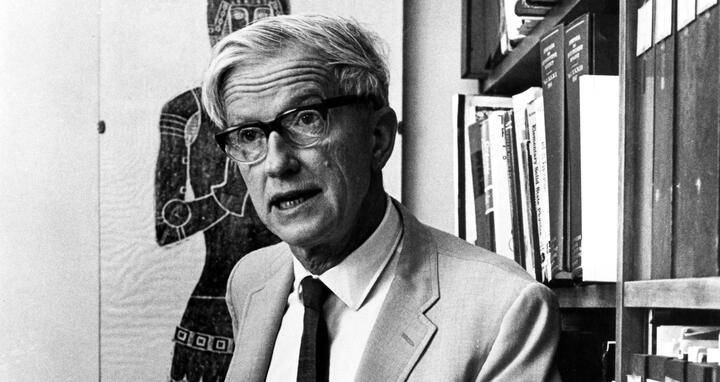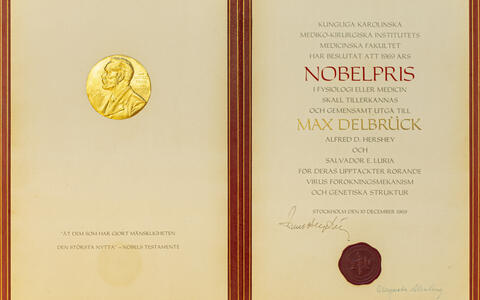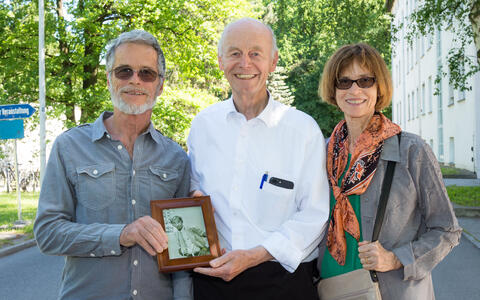The simplicity behind complexity
At least the trip to Stockholm was a pleasant surprise. The Swedes themselves took so much pleasure in the festivities surrounding the Nobel Prize that one could hardly resist it. Three friendly families were also staying on the fifth floor of the Grand Hotel, so that the week of December 10th, 1969, flew by in a pleasant atmosphere. Max Delbrück recalled this in an interview nearly ten years later.
He was suspicious of the ongoing attention that a Nobel Prize inevitably brings. He believed his achievement was comparable to that of many others. He also thought whoever ultimately wins the prize was always a throw of the dice. To this day, when asked about their father’s Nobel Prize, his children, say: “The whole thing took quite an emotional toll on him.”
This modesty should not obscure the fact that Max Delbrück was a great scientist and one of Berlin’s important sons. Throughout his life, he searched for simple principles behind complex phenomena. The physicist is one of the founders of a new scientific discipline, molecular genetics and molecular biology. And of course it is hardly a coincidence that in 1992 we named a new research center in the northeast of Berlin after him: the Max Delbrück Center for Molecular Medicine (MDC).
Still a role model today
In the early 1990s I set out on the trail of Max Delbrück (1906–1981), traced his connection to Berlin-Buch, met his scientific colleagues, and visited his wonderful wife Manny in the United States. She also presented us with the 1969 Nobel Prize diploma, which is now kept safely in Buch at the MDC.
Delbrück is connected to topics that are still guiding principles for researchers today: true interdisciplinarity that opens up new perspectives. Science as a creative, transparent process – very similar to the art that Delbrück was so connected to through the painter Jeanne Mammen. The conviction that science must remain free and independent of political influence, but must not evade its responsibility to society.
Max was the son of the famous historian Hans Delbrück, and his parents’ home in Grunewald was strict, but also open, a meeting place for famous scientists and intellectuals. The Harnacks socialized here, the Bonhoeffers were also part of the Delbrück’s social circle, and neighbors discussed politics, history, art, and science and made music together.
From astronomy to quantum mechanics
Max Delbrück, the youngest of six siblings, was looking for a niche that no one else had occupied: the natural sciences. Not always to the delight of his family, as he later recalled. As a boy, he liked to set a loud alarm clock at two o’clock in the morning, then sneak through his parents’ bedroom to the balcony and look at the stars through a telescope. Kepler was his idol. His mother mainly cared about his health and sewed the boy a particularly warm housecoat.
He gravitated toward astronomy and theoretical physics, and soon arrived in Göttingen, where a scientific revolution was underway. Here, Werner Heisenberg and Max Born developed quantum mechanics. Delbrück was inspired by this atmosphere. From then on, physics was a passion for him, also during his postdoctoral years in England, Switzerland, and Denmark.
Niels Bohr in Copenhagen stimulated his interest in biology. His principle of complementarity holds that two methodically different observations of a process or experiment are mutually exclusive, but nevertheless belong together and complement one another. Bohr was convinced that this argument applied not only to quantum mechanics, but also to the relationship between physics and biology.
What are genes?
Delbrück decided to become assistant to the nuclear scientist Lise Meitner in Berlin. He was thus close to several physically and biologically oriented institutes of the Kaiser Wilhelm Society, now known as the Max Planck Society. Since many Jewish colleagues were no longer allowed to work during this time, they met as small groups of physicists, biologists, and artists in private circles, often in the Delbrück parental home. These discussions resulted in collaborative experiments and a paper that laid the foundation of modern genetics: “On the Nature of Gene Mutation and Gene Structure,” published in 1935.
The question “What are genes?” was not a trivial one at the time. Mendel had long since described the laws of heredity, Darwin had introduced the concept of evolution, and Thomas Hunt Morgan of Columbia University in New York had experimented with fruit fly mutants, showing that genes are carried on chromosomes. However, a tangible concept of the gene did not yet exist. Biochemistry, too, had only just emerged. In Berlin-Buch, Delbrück met the Russian gene expert and brain researcher Nicolai Timofeeff-Ressovsky and his colleague, the radiobiologist Karl Günter Zimmer, who exposed fruit flies to X-rays in the laboratories of the Kaiser Wilhelm Institute and then searched for mutations.
Together, these three men – two biologists and one physicist – authored this study that caused a sensation. They described the gene as a physical unit for the first time ever, as an ordered “assemblage of atoms.” Energy alters these assemblages, they posited, leading to mutations. Their quantum mechanical model of a gene even made it possible to estimate its size. This was groundbreaking; an unprecedented and far-reaching thesis!
Inspiration for Schrödinger and Watson
Reprints circulated all over the world and inspired the physicist and Nobel Prize winner Erwin Schrödinger to write his book “What is Life?” (1944). This, in turn, led James Watson, who together with Francis Crick clarified the double helix structure of DNA, to this field. They received the Nobel Prize in 1962 for this achievement. A new era of science had begun. Watson has called Delbrück his mentor. In 1992, he played an active role in founding the Max Delbrück Center for Molecular Medicine (MDC) Berlin-Buch and visited us several times here.
Max Delbrück at the California Institute of Technology in Pasadena, USA, 1960.
But let’s go back to the beginning: In 1937, Delbrück left Nazi Germany on a research grant from the Rockefeller Foundation and traveled to the USA. He found outstanding conditions for his work at the California Institute of Technology (Caltech) in Pasadena.
In the United States, he met the colleagues with whom he would eventually share the Nobel Prize: Salvador Luria and Alfred Hershey. Like him, they wanted to investigate fundamental life processes and record quantitative data about them. Even fruit flies were considered to be too complex for this. Instead, they turned to microbes: How do the simplest forms of life – viruses and phages – manage to infect single-cell organisms such as bacteria and force them to produce thousands of viral copies? And how do the bacteria defend themselves?
New work drew on Berlin theses
Step by step, in experiments which can now be found in every (good) textbook, the three researchers solved the riddle. Hershey discovered that the instructions for making viruses had to be encoded in the nucleic acids – because only nucleic acids enter the bacterial cells, whereas the protein coat is left “outside.” Meanwhile, Luria and Delbrück showed that among the billions of bacteria in a culture there are usually several bacteria resistant to the viral infection as the result of a random mutation. These bacteria are already adapted to the new environmental conditions before they occur. They offered substantial insight into the nature of viruses and viral diseases, said the Nobel Prize jury. At the same time, they discovered the fundamental mechanisms of the genome. In this way, their work tied in with the earlier Berlin theses.
Delbrück never returned to Germany permanently after the end of the National Socialist regime. He had married in the United States and founded a family. In 1945 he was granted US citizenship. Nevertheless, he remained closely connected to his homeland and influenced the development of molecular biology worldwide, including in Germany. He held a visiting professorship in Göttingen. At the end of the 1950s, he established the famous Institute for Genetics at the University of Cologne, and ten years later he co-founded the Department of Biology at the University of Constance. He also maintained close contact with Berlin and, in particular, with research being conducted in Buch. He supported individual GDR researchers by sending them important scientific journals. In this respect, Max Delbrück was an innovator and supporter of the German science and research system after World War II.
Always maintained his independence
The naming of the Max Delbrück Center for Molecular Medicine (MDC) in Berlin-Buch was not only an act of recognition, but also a commitment to a program. Delbrück always remained personally, politically, and scientifically independent and never allowed himself to be roped in or used by any side of the political spectrum. He always donated prize money – including his share of the Nobel Prize – to Amnesty International. Delbrück justified his decision as follows: “In my case, I feel that I owe my life as a scientist to the fact that I did not stay in Germany during the Nazi era to take part in the resistance in one form or another. Many did so and paid for it with their lives. It is in memory and as a debt to these prisoners of conscience that I want to support Amnesty International. The search for the truth is a multifaceted endeavor. Science is one such search.”
Max Delbrück loved art, poetry, and theater. Together with students, there were numerous performances at Cold Spring Harbor. The Berlin-based painter Jeanne Mammen was and remained a close friend from the 1930s. Scientists and artists are people who do not shy away from problems, but tend to seek them out – the bigger, the more interesting! Times of upheaval stimulate artists’ and scientists’ creativity. They need this stimulus to create something new.
Tradition provides role models
Berlin is a city that experienced upheavals like no other. Nothing is the same as it was 30 years ago – both in the East and in the West. Berlin is poised to once again become a globally recognized science hub and “healthcare city.” This represents more than improved patient care and cooperation between hospitals, more than a good IT infrastructure or a high concentration of economically successful companies. “Together – one whole” is how the Charité rightly describes its new strategy of interdisciplinary and cross-structural collaboration, involving the MDC and other research institutions. The “Global Health” focus of the Berlin University Alliance in the Excellence Initiative should be understood in this sense of interdisciplinary collaboration.
Detlev Ganten with Delbrück's children Jonathan Delbrück and Nicola Salmon.
Health research is important for people and society, but it is also a particularly complex field. With their reductionist models for solving special problems, scientists such as Max Delbrück, Erwin Schrödinger, and others have shown how interdisciplinary basic research can contribute to the advancement of medical knowledge. Scientists at the MDC continue to use this approach in their own research – such as when they analyze gene regulation or single cells or make advances in immunobiology. An international evaluation recently found their work to be “outstanding.” MDC scientists use high-throughput methods to make findings regarding fundamental questions of biology, and then apply system analysis techniques and artificial intelligence to integrate the individual results at the organ and whole-body levels – in order to understand the molecular basis of health and disease. Discoveries are translated into the prevention, diagnosis, and treatment of disease at the Berlin Institute of Health and at the Charité using a new holistic translational research approach. As a result, the findings are incorporated into future healthcare practice, which in turn requires interdisciplinary collaboration on a broad scale.
Tradition provides role models. The “Berlin School” of medicine of the 19th century, including Virchow, Koch, Behring, Ehrlich, and others, was successful because it welcomed new fields of science and technology that were emerging at the time. Max Delbrück is part of this tradition. In human, political, and scientific terms, he is a pioneer and role model for modern research, characterized by molecular, reductionist methods for understanding an increasingly complex, interdisciplinary, and modern science. Berlin can not only be proud of this tradition, but also draw strength from it for the strategy and future of the healthcare city Berlin 2030! Max would have been delighted!
This article first appeared – in a shorter version – in the daily newspaper Tagesspiegel. Clinical pharmacologist Professor Detlev Ganten was founding director of the Max Delbrück Center for Molecular Medicine in the Helmholtz Association (MDC), leading the center from 1992 to 2004. He then served as Chairman of the Executive Board of Charité – Universitätsmedizin Berlin, where he oversaw the merging of the medical faculties of Freie Universität Berlin and Humboldt-Universität zu Berlin. Professor Ganten is President of the World Health Summit, which he founded in Berlin in 2009.








